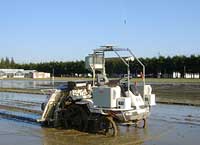|
|
|||||||
|
|
|||||||
|
|||||||
| | Web Japan >> | Trends in Japan >> | Science & Technology >> | Rice-Planting Robot | |
|
RICE-PLANTING ROBOT Scientists Test GPS-Guided Device in Rice Paddy (October 14, 2005)
Bringing Hi-Tech to the Farm Researchers conducted trials in Saitama Prefecture in April 2005 in which the robot planted a rice paddy without any human intervention. To find its way around, the device relies on the global positional system (GPS), which is also used in car navigation devices. Tilt sensors and other instruments calculate the angle and direction of the machine's movements, which are computer controlled, so that the robot has a precise understanding of its position in the paddy. The robot is expected to be used with a new technique called long-mat hydroponics. In this method, rice seedlings are put in mats about 6 meters long and then rolled onto planters that plant the seedlings into paddies. The mats are light, making it easy to transport the seedlings, while the number of times the planters require reloading is cut drastically. There are high hopes for this next-generation technology. The robot incorporates technology well suited to carrying out this task. It is able to move across paddies in very precise directions, within a 10-centimeter margin of error, even when no human is around to control it. The machine can also make a U-turn on its own once it reaches the edge of a paddy to continue with the planting. The robot can plant at a speed of 1,000 square meters every 20 minutes without having to reload seedlings. New Hope for Japanese Farming The robot is one of several hi-tech innovations under development in the farming business. Radio-controlled devices, such as boats, are already in use on some farms, while various other types of robots are under development for harvesting fruit and vegetables. For example, an organization in Yamagata Prefecture that has been using ducks to destroy weeds in rice paddies instead of chemicals or fertilizers would like to switch over to robots. Research on the project is being conducted at technical high schools and other facilities. The ultimate aim of these efforts is to create "robot farms" where nearly all the chores, including planting, weed control, and harvesting are done by machines. It is an ambitious goal, as farming robots, unlike their industrial cousins working in factories, must operate in harmony with nature. Even so, the day when a significant proportion of farm labor is done by robots may not be far off. Copyright (c) 2005 Web Japan. Edited by Japan Echo Inc. based on domestic Japanese news sources. Articles presented here are offered for reference purposes and do not necessarily represent the policy or views of the Japanese Government. |
FARMING RICE WITH DUCKS (October 22, 2002) |
|||||||
|
||||||||



